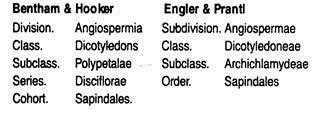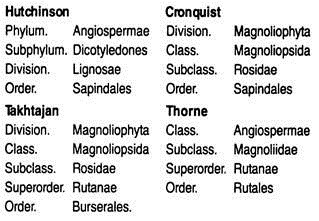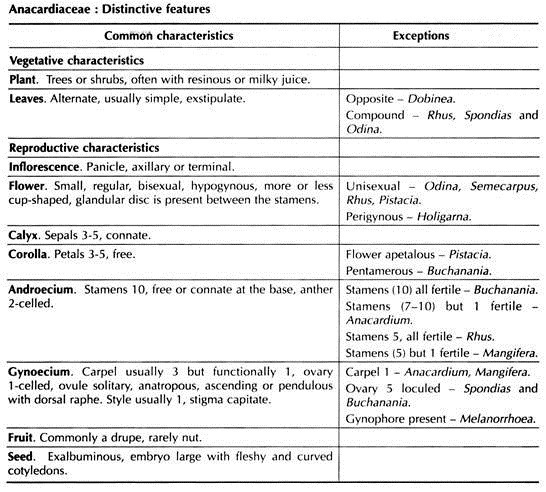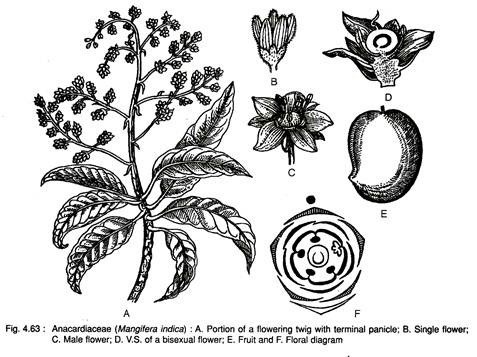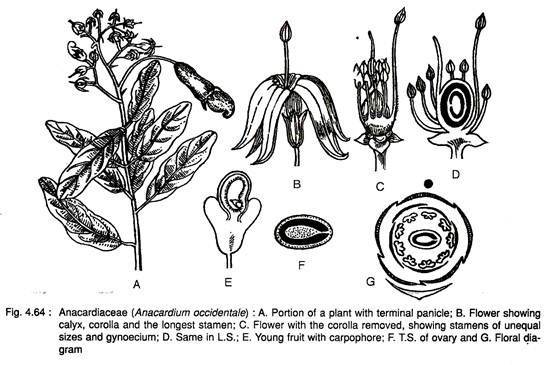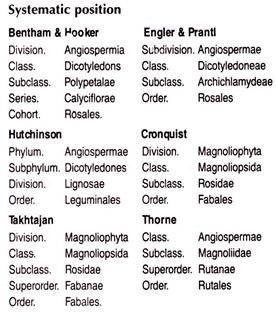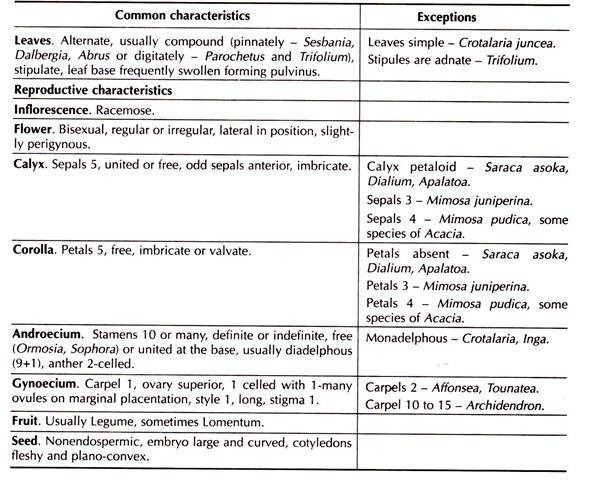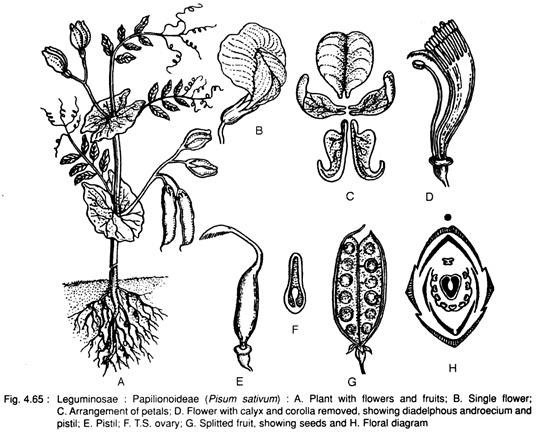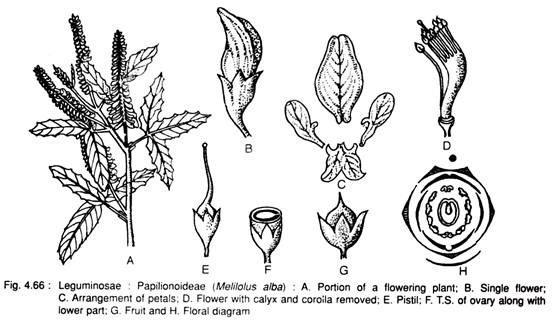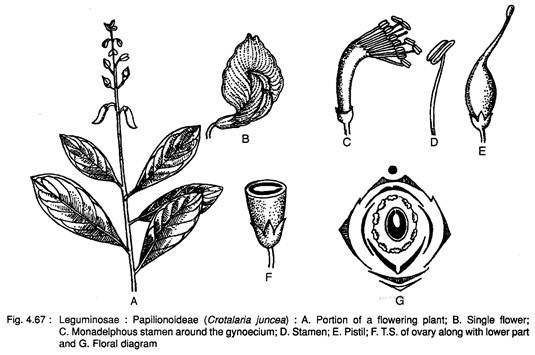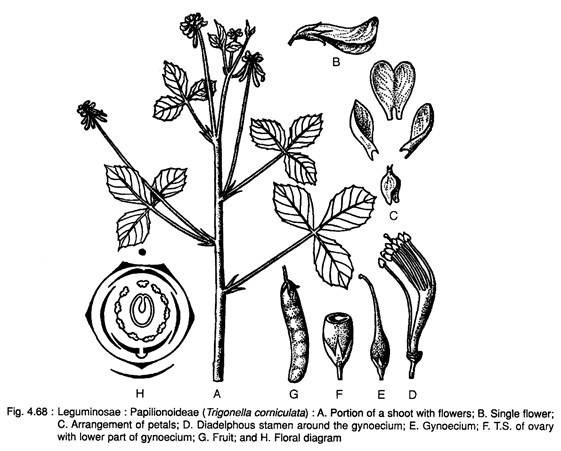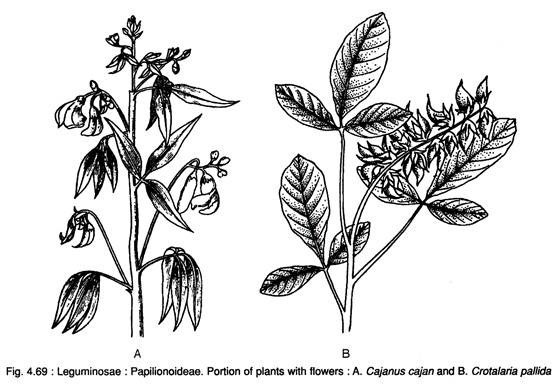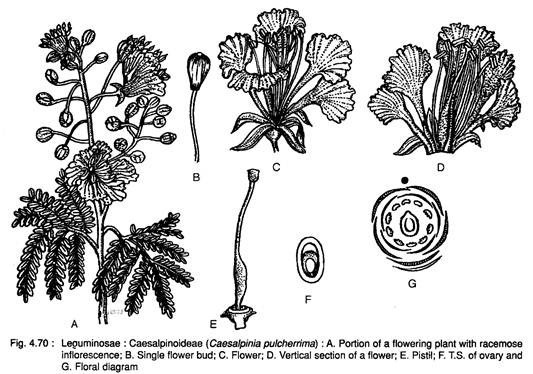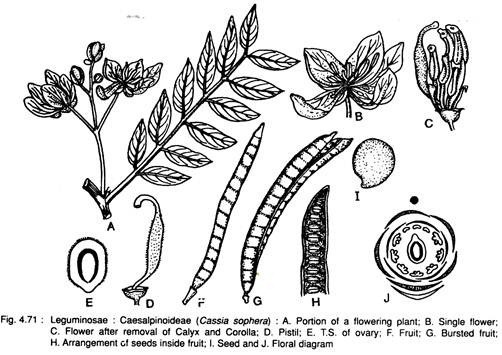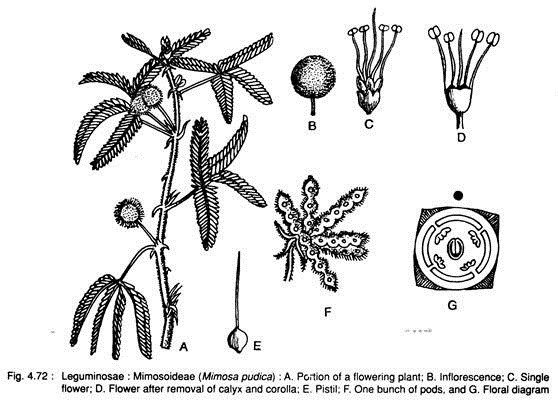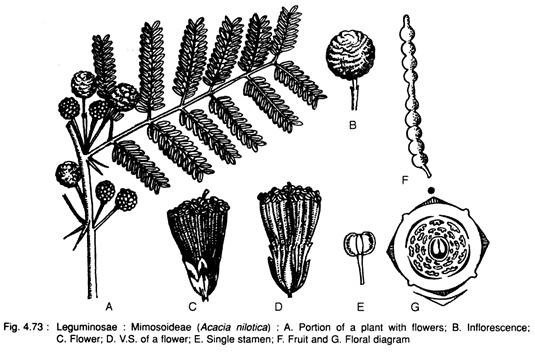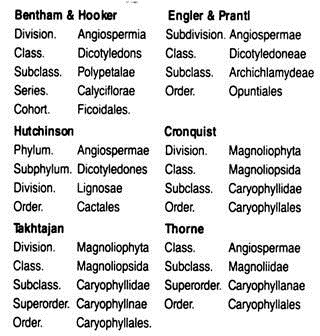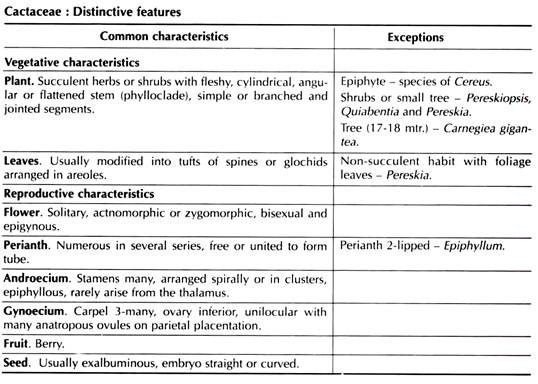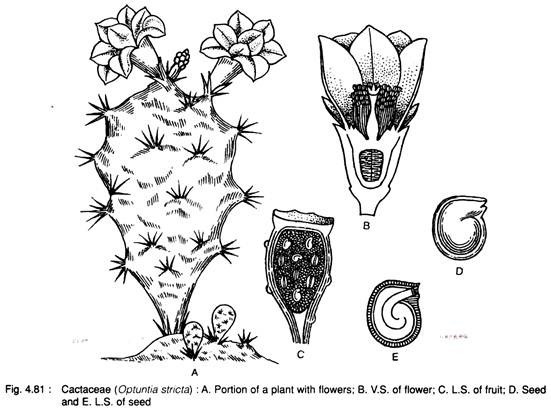Are you looking for an essay on ‘Dicotyledons’? Find paragraphs, long and short essays on ‘Dicotyledons’ especially written for school and college students.
1. Essay on Anacardiaceae (Cashew or Sumac Family):
The family Anacardiaceae is represented by 70 genera and about 615 species, distributed mostly in tropical regions and some members are found to grow in temperate regions of Asia, America and also in Europe. About 22 genera and 110 species are commonly found in Himalayan range of India.
The type genus of the family is Anacardium.
Systematic Position:
Identifying Characteristics:
1. Plant shrub or woody trees.
2. Leaves generally simple, exstipulate and alternate.
3. Inflorescence usually axillary or terminal panicle.
4. Stamens commonly 10, often reduced to 1, develop from or under the intrastaminal disc.
5. Ovary superior, carpel 1-5, 1-5 chambered, with marginal or axial placentation.
6. Fruit drupe.
Floral Formula:
Phylogeny and Systematic:
The family is closely related with Sapindaceae and Rutaceae.
Bentham and Hooker placed Anacardaceae in the Cohort (= Order) Sapindales under the Series Disciflorae, Subclass Polypetalae of Class Dicotyledons.
They divided the family into two tribes:
1. Anacardieae. Ovary commonly 1 -celled, e.g., Mangifera, Anacardium, Pistacia etc.
2. Spondieae. Ovary 2-5 celled, e.g., Dracontomelum arid Spondias.
Airy Shaw (1973) separated the genus Pistacia and placed it in a separate family Pistaciaceae for the following characteristics:
1. Plants are dioecious,
2. Absence of petals, and
3. Structure of pollen grains.
Engler and Prantl placed the family under the Order Sapindales, Subclass Archichlamydeae of Class Dicotyledoneae. Hutchinson also placed the family under the Order Sapindales and placed it near Rutales.
Most of the taxonomists placed the family under Sapindales, but Takhtajan (1960, 80) placed it under Rutales instead of Sapindales.
Common Plants:
1. Anacardium occidentale L. (Cashew nut);
2. Buchanania lanzan Spreng. (Syn. B. latifolia Roxb.) (Piyal);
3. Mangifera indica L. (Mango);
4. Semecarpus anacardium L. f.;
5. Spondias pinnata (L. f.) Kurz. (Syn. S. mangifera Willd);
6. Odina woodier Roxb (Syn. Lannea coromandelina Merr.).
Key to Genera:
I. Ovary 1- or 2-Celled:
1. Leaves alternate; perianth not fleshy …
i. Calyx 4-5; corolla 4-6; leaf pinnate. …………………. Rhus.
ii. Calyx 4-5; stamens 5 (usually 1 fertile); style 1, filiform; leaf simple. …………………………………. Mangifera.
iii. Calyx 5; stamens 8-10 (usually with staminodes): style 1, filiform; torus striated; leaf simple. …………………… Anacardium.
iv. Calyx 3-5; stamens 10; carpels 5 or 6 (all but one sterile), leaf simple………… Buchanania.
2. Leaves 3-foliate or pinnate; petals imbricate; stamens 8-10; styles 3-4; flowers polygamous……………………………….. Odina.
3. Leaves simple
Petals imbricate; stamens 5; styles 3; fruit drupe on an enlarged peduncle…………….. Semecarpus.
II. Ovary 2-5-celled; ovules pendulous from the top; leaves compound; flowers polygamous;
stamens 8-10; styles 4-5, free above……………………………. Spondias.
Plants of Economic Importance:
A. Fruits:
1. Mangifera indica (Mango). The ripe fruits are very much tasty. The unripe fruits are eaten directly with salt and also used in pickles.
2. Spondias pinnata (Hog-palm). The fruits are used in making jelly.
B. Seeds:
Anacardium occidentale (Cashew nut) and Pistacia vera (Pistachio nut). The seeds are tasty and very much highly priced in the market.
C. Other Uses:
1. Odina woodier. The gum collected from the stem bark is used in confectionary.
2. Rhus glabar. The resinous juice of the .plant is used for tanning.
3. Toxicodendron vernicifera and Pistacia lentiscus: Resins, oils and lacquers are obtained from these plants.
2. Essay on Leguminosae (Fabaceae):
(Legume Family)
The family Leguminosae is represented by about 630 genera and 18,000 species, found to grow in different habitat throughout the world. In India, the family is represented by about 138 genera and 900 species. It is the third largest family of flowering plants and second from the economic point of view.
The type genus of the family is Faba.
Identifying Characteristics:
1. Plants herbs, shrubs or tree; commonly with root nodules.
2. Leaves usually compound, mostly alternate, stipulate, often with pulvinus (the swollen base of the petiole).
3. Flowers bisexual, hypogynous or perigynous.
4. Sepals 5, odd sepals anterior.
5. Petals 5, free.
6. Carpel-1, 1-chambered, placentation marginal.
7. Fruits legume or lomentum.
Subdivisions of the Family:
This family is the second largest family of the members of phanerogams.
The family has been divided into three subfamilies based mainly on the characteristics of flower:
A. Papilionoideae
B. Caesalpinioideae and
C. Mimosoideae.
A. Papilionoideae:
Leaves are imparipinnate; Inflorescence raceme; Flower solitary or in raceme, irregular (papilionaceous); Petals 5, vaxillary in aestivation, posterior petal biggest and outermost; Stamens usually 10, commonly diadelphous (9) +1, sometimes monadelphous (Crotalaria, Arachis etc.) rarely 9 (Abrus); Embryo curved, viz., Desmodium, Crotalaria, etc.
B. Caesalpinoideae:
Leaves are usually paripinnate or bipinnate; Inflorescence raceme or corymb; Flowers slightly irregular (but not papilionaceous); Petals 5, imbricate, posterior petal innermost and smallest; Stamens 10 or less some are sterile. Embryo straight, viz., Cassia, Bauhinia, Caesalpinia etc. [Some exceptions: Herb-Cassia absus, C. tora; Woody climber- Caesalpinia bonducella; Climbing by stem tendril-Bauhinia vahlii.]
C. Mimosoideae:
Leaves are usually bipinnate; Inflorescence head or spike; Flowers regular (actinomorphic); Petals 4, united or free, valvate; Stamens all fertile-numerous, sometimes definite and exerted; Embryo straight, viz., Mimosa, Acacia, etc.
Distribution of the Subfamilies:
A. Papilionoideae:
The subfamily Papilionoideae is represented by about 440 genera and 12,800 species, grows abundantly in the tropical and subtropical regions of the world. About 100 genera and more than 748 species are found to grow in the Himalayas and Peninsular India. Economically the subfamily is very much important than the other two subfamilies.
B. Caesalpinoideae:
The subfamily Caesalpinoideae is represented by about 150 genera and 2,700 species, grows in both tropical and subtropical regions, but are very common in America. In India, the subfamily is represented by 23 genera and 80 species, found to grow abundantly in tropical region of Eastern Himalayas and also in the western part of Peninsular India.
C. Mimosoideae:
The subfamily Mimosoideae consists of about 40 genera and 2,500 species, found to grow in tropical and subtropical regions, but profusely grows in Southern Hemisphere. In India, it is represented by 15 genera and 72 species, grow commonly in western part of Peninsular India and also in tropical and subtropical Himalayas.
Floral Formula:
Subfamily. Papilionoideae
Subfamily. Caesalpiniodeae
Subfamily. Mimosoideae
Phylogeny and Systematic:
The family Leguminosae is closely related to Rosaceae.
Bentham and Hooker placed the Natural order (= family) Leguminosae in the cohort Rosales of series Calyciferae, subclass Polypetalae and class Dicotyledons. The family is divided into three subfamilies as Papilionoideae, Caesalpiniodeae and Mimosoideae.
Engler and Prantl placed the family Leguminosae under the order Rosales of subclass Archichlamydeae and class Dicotyledoneae.
Hutchinson treated the family Leguminosae as a separate order Leguminales which contains three independant families: Mimosaceae, Caesalpiniaceae and Papilionaceae. Takhtajan and Thorne treated Leguminosae as a family Fabaceae after the Type genus Faba. Takhtajan placed this family under the order Fabales of the superorder Fabonae while Thorne placed it under the order Rutales of the superorder Rutanae.
Common Plants:
Subfamily. Papilionoideae:
1. Abrus precatorius L.
2. Aeschynomene aspera L.;
3. Butea monosperma (Lam.) Taub.;
4. CIitoria ternatea L.;
5. Crotalaria pallida Aiton. (Syn. C. striata DC.);
6. Desmodium gyrans DC.;
7. Dalbergia sissoo Roxb.;
8. Erythrina indica Lamk;
9. Indigofera tinctoria L.;
10. Pongamia pinnata (L.) Pierre.;
11. Pterocarpus marsupium Roxb.;
12. Tephrosia purpurea Pers. etc.
Subfamily. Caesalpinioideae:
1. Bauhinia purpurea L.;
2. B. acuminata L.
3. Caesalpinia pulcherrima Sw.;
4. Cassia sophera L.;
5. C. tora L.;
6. C. fistula L.;
7. Delonix regia Raf.;
8. Peltophorum ferrugineum Berth.
9. Tamarindus indicus L.
Subfamily. Mimosoideae:
1. Acacia auriculiformis A. Cunn.;
2. A. arabica Willd;
3. Albizzia lebbeck Benth;
4. Entata pursaetha DC.;
5. Inga dulcis Willd. (Syn. Pithecolobium dulce Benth.);
6. Mimosa pudica L.;
7. Samanea saman (Jacq.) Merr. etc.
Key to Sub-Families:
I. Flowers Irregular:
1. Stamens diadelphous, very often monadelphous; posterior petal outermost. …………………………………… Papilionoideae.
2. Stamens free; posterior petal innermost. ……………….. Caesaipinioideae.
II. Flowers Regular:
Flowers regular……………………. Mimosoideae.
Key to Genera:
Papilionoideae:
I. Stamen Free:
1. Straggling or scandent shrubs; leaves 1-foliate; bracteoles large, hiding flowers. …………………………… Dalhausiea.
2. Shrubs; leaves imparipinnate; bracteoles 0. ………………………… Sophora.
3. Erect trees; leaves imparipinnate; bracteoles minute. ……………………………. Ormosia.
II. Stamens Monadelphous:
1. Prostrate herbs; leaves pinnately compound with 2 pairs of leaflets; fruit hypogeal burying itself to ripen underground. …………………………. Arachis.
2. Annual herbs; leaves digitately 3- or 4- foliate, gland-dotted. …………………….. Zornia.
3. Herbs or shrubs; leaves simple, sessile, or digitately 3-7-foliate; fruit turgid, non- septate, dehiscent. …………………………… Crotalaria.
4. Stem woody and twining; leaves paripinnate; stamens (9), petals vexillary, filament absent. ………………………. Abrus.
5. Large twining or prostrate herbs …
i. Leaves pinnately 3-foliate ……………… Canavalia.
ii. Leaves pinnately 3-foliate, leaflets lobed. ……………………………… Pueraria.
iii. Leaves pinnately 3-foliate, 5 alternate stamens sterile. …………………………. Teramnus.
III. Stamens Diadelphous:
A. Herbs; pods dehiscent by both sutures …
Leaves paripinnate, rachis ending in a bristic or tendril …
1. Leaflets deeply toothed; pod turgid, sessile, tipped with beardless style. ………….. Cicer.
(C. arietinum has usually a terminal leaflet instead of a tendril).
2. Leaflets entire, rachis ending in a twisted tendril, staminal tube oblique at its mouth
i. Style bearded at the tip; ovule usually more than two; pod compressed. ………………………………………….. Vicia.
ii. Style longitudinally bearded along inner surface; ovules never more than two; fruit a compressed 1-2-seeded pod. ………………………………. Lens.
iii. Style flat, bearded along inner face and dilated above; fruit many-seeded pod, compressed. …………………………….. Lathyrus.
iv. Style 3-comered, dilated upwards; pod turgid. …………………….. Pisum.
B. Herbs; pods indehiscent or dehiscent along the ventral suture …
Leaves pinnately 3-foliate, veins produced as marginal teeth in leaflets, stipules adnate …
i. Flowers yellow or white; pod nearly round, 1- or 3-seeded. …………. Melilotus.
ii. Flowers usually purple, violet or blue, sometimes yellow; pods larger than calyx, downy and loosely spiral. ………………………….. Medicago.
iii. Flowers white or yellow; pod long, thin and jointed. ……………. Trigonella.
iv. Flowers usually reddish or purple; pod slender, 1- or more seeded. ………………………… lndigofera.
v. Flowers blue; pod 1-seeded, indehiscent. ………………………… Psoralea.
C. Herbs or undershrubs; leaves pinnate, sensitive, 3-5 pairs, exstipulate, the rachis ending in a bristle or leaflet; flowers bright yellow; stamens in 2-bundles of 5 each; fruit a lomentum, folded inside the calyx. ……………………….. Smithea.
D. Undershrubs growing in jheels and ditches, soft-wooded; leaves imparipinnate, numerous, sensitive; flowers bright yellow or orange- yellow; stamens in 2 bundles of 5 each; fruit a long lomentum, exserted. ……………………… Aeschynomene.
E. Herbs or undershrubs; leaves stipulate, leaflets 1 -9; stamens (9)+1; fruit lomentum, coiled and more or less folded within the calyx … Uraria.
F. Herbs or undershrubs; leaves 3-1-foliate; pod flat, not coiled; stamens (10) or (9)+1 ……………………… Desmodium.
G. Herbs or undershrubs; leaves pinnately 3-foliate, not glandular beneath
Twining, style bearded below stigma …
i. Keel spirally twisted; stigma oblique ………… Phaseolus.
ii. Keel not spiral; stigma oblique…. Vigna.
iii. Leaflets lobed, stigma oblique, tuberous rootstocks. ………………. Pachyrrhizus.
iv. Stigma terminal; pod flattish, winged ……….. Dolichos.
v. Pod square, winged……… Psophocarpus.
vi. Standard shorter than keel and wings; pods usually beset with stinging hairs. ………. Mucuna.
H. Trees with prickly branches; keel and wings shorter than standard; leaflets more or less cordate. ……………………… Erythrina.
I. Trees or woody climbers; flowers large showy, orange-red; calyx silky, wings free from keel …………………….. Butea.
J. Woody twiners; flowers small; corolla not much larger than calyx; wings adnate to the Keel. …………………………… Spalholobus.
K. Trees undershrubs, or climbers, pod dehiscent or indehiscent.
Leaves pinnately 5 or more foliate with terminal leaflet…
(a) Pod Flat, Indehiscent:
i. Woody climbers or trees
Leaflets alternate; stamens (9)+1 or (10) or (5)+ (5) ……… Dalbergia.
ii. Timbers trees; flowers yellow
Leaflets alternate; stamens as above; pod thin, orbicular ………….. Pterocarpus.
iii. Trees; leaflets opposite; flowers pink or white; ovary 2-ovuled; pod almost woody, wingless ……………………… Pongamia.
(b) Pod Dehiscent:
i. Herbs or shrubs, usually climbing Flowers blue, white or purple; standard spoon-shaped; stamens (9)+1 or (10); anthers uniform…….. Clitoria.
ii. Erect herbs or undershrubs, more or less hairy with an offensive smell; leaflets imparipinnate, with 6-10 pairs; flowers red or purple ……………………… Tephrosia.
iii. Herbs, shrubs or soft-wooded trees, sometimes prickly; leaves paripinnate; leaflets may be 40 pairs; flowers large, yellow, dotted with purple or white or red; roots with copious tubercles ………….. Sesbania.
Caesalpinioideae:
I. Leaves simple, 2-lobed……………….. Bauhinia.
II. Leaflets paripinnate …
A. Calyx 5, Petals 5, Stamen 10, anthers basi- fixed …………..Cassia.
B. Calyx petaloid, scarlet, 4-lobed; corolla 0; Stamens. 8 ………….Saraca.
C. Petals 0; calyx 5-lobed, green; stamens 10; leaflets 1-3, jugate ………….Hardwickia.
D. Petals 3; stamens 3, monadelphous ………….. Tamarindus.
III. Leaflets bipinnate …
A. Trees, rusty tomentose shoots and rusty panicles or showy yellow flowers ……………… Peltophorum.
B. Trees, shrubs or prickly climbers Calyx deeply cleft, the lowest lobe largest; petals orbicular, usually clawed ………………….. Caesalpinia.
C. Unarmed trees; Calyx-lobes valvate and almost equal, flowers large, bright scarlet and variegated with yellow … Poinciana.
D. Small armed trees; main leaf-rachis spinescent, pinnae with much-flattened rachis, small ……………. Parkinsonia.
Mimosoideae:
I. Stamens definite, 4, 5, 8 or generally 10 …
A. Marshy plants with flattened or angular stems; heads of flowers on long stalks; flowers hermaphrodite, male or neuter ………………………………………………… Neptunia.
B. Flowers in round heads, all flowers similar
(a) Woody tree, leaf with one pair of Pinnae …………..Xylia.
(b) Woody climber with tendrils…Entada.
(c) Erect unarmed tree with bipinnate leaves, fruit linear, falcate, seeds scarlet ……………….. Adenanthera.
(d) Prickly trees or shrubs, pod turgid and spongy inside ………… Prosopis.
(e) Herbs or shrubs with sensitive leaflets, pod flat and jointed ……….. Mimosa.
II. Stamens indefinite, much exerted …
A. Erect or climbing shrubs or trees armed with spiny stipules or recurved prickles; flowers white, yellow or purple in round heads or cylindrical spikes…….. Acacia.
B. Large unarmed trees, rarely climber; leaves bi-pinnate, pinnae and leaflets several; flowers in round heads; stamens monadelphous; pods thin, strap-shaped, continuous within Albizzia.
C. Tall trees; leaves bipinnate with pinnae one pair and leaflet one pair only, sometimes spinescent; stamens monadelphous; pod twisted…………………………….. Iinga.
D. Big trees; leaves bipinnate, leaflets many; stamens monadelphous; pod septate between seeds, valves spongy or fleshy … ……………………………………… Enterolobium.
Genus Crotalaria:
Key to Species:
1. Small herb; leaves simple………………. albida.
2. Undershrub; leaves compound, 3-foliate ……….. striata.
Genus Desmodium:
Key to Species:
1. Leaves trifoliate; flowers solitary… triflorum.
2. Leaves unifoliate; flowers solitary……………………. gangeticum.
Genus Cassia:
Key to Species:
1. Pods impressed between the seeds…………………. occidentales.
2. Pods not impressed between the seeds.
i. Leaflets usually 3 pairs, oblong-ovate. …………………… tora.
ii. Leaflets 7-10 pairs, lanceolate. … sophera.
Plants of Economic Importance:
Subfamily. Papilionoideae
A. Vegetables:
The fruits of the following species are used as vegetables:
1. Canavalia ensiformis (Jack bean).
2. Cyamopsis tetragonolobus (Cluster bean, Gwar).
3. Dolichos lablab (Sim).
4. Glycine max (Soybean, Soya).
5. Phaseolus vulgaris (Kidney bean).
6. P. lunatus (Lima bean).
7. P. coccineus (Multiflora bean).
B. Pulses:
Seeds of different species have high content of protein and starch used widely as food.
The commonly used plants are:
1. Cajanus cajan (Pigeon pea, Arhar).
2. Cicer arietinum (Chick pea, Gram, Chola).
3. Glycine max (Soyabean, Soya).
4. Lens culinaris (Lentil, Masur).
5. Pisum sativum (Garden pea, Matar).
6. Phaseolus mungo (Black gram, Mushkalai).
7. P. aureus (Green gram, Mung)
8. Vigna aconitifolia (Moth).
C. Oils:
Arachis hypogea (Groundnut). The oil extracted from the seeds is used as vegetable oil. The oil is used in the manufacture of vanaspati. It is also used in cosmetics and soap industry. The oil cake is used as fodder and fertiliser.
D. Fibres:
1. Crotalaria Juncea (Sunhemp):
The bast fibre extracted from the stem is very strong and is used in making ropes, gunny bags, hair of goddess, etc.
2. Sesbania Cannabina:
The plant also yields good quality of fibre.
E. Timbers:
The following are the valuable timber yielding plants found in this subfamily:
1. Dalbergia latifolia (Rose wood).
2. D. sissoo (Sissoo).
3. Pterocarpus dalbergioides (Red wood)
4. P. indicus (Malay padauk).
5. P. marsupium (Indian kino tree).
6. P. santalinus (Red sandal wctod).
F. Fodder:
Medicago sativa and different species of Trifolium (clover) i.e., Trifolium alexandrinum, T. hybridum, T. pratense, T. repens are used as fodder.
G. Dyes:
1. Indigofera Tinctoria, I. Sumatrana and I. Suffruticosa:
The plants are the source of ‘indigo’ dye used in printing, dyeing and paints.
2. Pterocarpus Santalinus:
The red resinous substance ‘santalin’ extracted from wood is used for dyeing silk and cotton cloths.
H. Gum:
Different species of plants are the source of gum used in paper and textile industry and also in food:
1. Astragalus Gummiferus:
The ‘Tragacanth’ gum found from this plant is used in textile industry as a sizing material and in cosmetic and confectionary as emulsifier.
2. Cyamopsis Tetragonolobus (Cluster Bean):
The ‘Gwar gum’ is extracted from the seeds used in paper and textile industry, etc.
I. Medicines:
Many plants are used as the source of drugs.
These are:
1. Abrus Precatorius:
The roots and leaves are used to control cough and cold.
2. Glycyrrhiza Glabra:
The medicine Liquorice, extracted from the root and stem, used in cough syrups.
3. Krameria Triandra:
The drug “Krameria” extracted from the roots is used to control chronic inuate.
4. Moghania Strobilifera:
The decoction of the roots is used to relieve pain and induce sleep.
5. Psoralea Corylifolia:
The seeds are used in the treatment of leprosy, leucoderma and also as laxative.
6. Teramnus Labialis:
The plants are used in the treatment of tuberculosis, rheumatism, etc.
J. Ornamental Plants:
Various members of this subfamily are grown as ornamental plant.
Some of them are:
1. Clitoria ternatea (Butterfly pea).
2. Erythrina indica and E. variegata (Mother plant).
3. Pongamia pinnata (Pongam oil tree).
4. Sesbania sesban (Common sesban).
5. Sophora japonica (Japanese pagoda tree).
6. Wisteria sinensis (Chinese wisteria).
K. Other Uses:
1. Aeschynomene Aspera:
The dried soft stem is the ‘shola’ of commerce used in various decoration purposes.
2. Abrus Precatorius:
The seeds are light in weight and used by goldsmiths for necklace and also as jewellers weight.
Subfamily. Caesalpinioideae:
A. Vegetables:
Bauhinia purpurea (Deva kanchan) and B. variegata (Camelis foot tree, Rakto kanchan). The flower buds of both the plants are used as vegetables and also used in pickles.
B. Medicines:
1. Cassia Fistula (Indian Laburnum, Bandar Lathi):
The fruits are used as laxative.
2. Cassia Sophera (Kalkashunda, Kasunda):
The decoction of leaves is used in the treatment of bronchitis and ringworm.
3. Cassia Surattense (Syn. C. Glauca):
The bark of stem and leaves are used in the treatment of gonorrhoea and diabetes.
4. Saraca Asoka:
The decoction of bark is used in the treatment of menstrual disorder of women.
C. Dyes and Tanning:
1. Bauhnia Malabarica, B. Purpurea and B. Racemosa:
The barks yield tannin of commerce — widely used in tanning.
2. Caesalpinia Digyna and C. Sepiaria:
The bark of both the plants yield tannin of commerce — widely used in tanning.
3. Caesalpinia Sappan (Sappan):
The heart- wood contains a red-orange dye used in dyeing wool, cotton and silk cloths.
4. Hematoxylon Campechianum:
The dye hematoxylin is extracted from the heart- wood — used as laboratory reagent.
D. Ornamental Plants:
A number of plants are grown as ornamentals.
These are:
1. Bauhinia acuminata, B. purpurea, B. racemosa and B. variegata.
2. Cassia alata, C. fistula, C. marginata, C. nodosus, C. siamea and C. surattense.
3. Caesalpinia pulcherrima (Peacock flower, Krishnachura).
4. Delonix regia (syn. Poinciana regia) (Goldmohur tree, Gulmohur).
5. Milettia ovalifolia (Plant with beautiful mauve i.e. bluish flowers in drooping raceme).
6. Peltophorum pterocarpum (Caper pod. Roadside tree with yellow flower, Radhachura).
7. Saraca asoka (syn. Saraca indica )(Ashok).
E. Other Uses:
1. Bauhinia Anguina, B. Macrostachya and B. Tomentosa:
The fibre is extracted from the bark used locally in various purposes.
2. Bauhinia Racemosa, B. Variegata and B. Retusa:
The gum extracted from the plants is of various uses.
3. Ceratonia Siliqua:
The Caroh gums extracted from the seeds are used commercially in sizing fabrics, printing and tanning.
4.Hardwickia Binata (Anjan):
The timber of the plant is used in bridges, ploughs, cart wheels, etc. The fibres from the bark are used in rope making.
5. Phanera Vahlii (Camelfs Foot Climber):
The gum extracted from the plants is of commercial importance.
6. Tamarandus Indicus (Tamarind Tree, Tentul):
The pulp of the fruit is acidic and used in sauces, curries, chutney, etc.
Subfamily. Mimosoideae:
A. Edibles:
1. Neptunia Prostrate:
Apical region of the stem and the pods are used as vegetable.
2. Pithecolobium Dulce:
The juicy and sweet aril is edible. (Aril: an outgrowth from the funiculus or hilum of a seed, which is often spongy and gelatinous, and sometimes covered the seed.)
B. Timbers:
1. Acacia Catechu, A. Nilotica, A. Modesa:
The stems of the plants are used as source of fuel, cart wheels, tool handles, etc.
2. Albizzia Amara, A. Lucida, A. Chinensis, A. Lebbeck:
The timbers of the above plants are valuable and used for furniture, agricultural implements, etc.
3. Xylia Xylocarpa (Syn. X. Dolabriformis):
The stem is used in the construction of boat, etc.
C. Tannins:
Acacia nilotica, A. catechu, A. pinnata. The tannins extracted from the bark are used for various purposes.
D. Gums:
1. Acacia Catechu:
The gum (Khair or Katha) extracted from the bark is used for dressing of betel leaf during preparation of ‘paan’.
2. A. Nilotica:
The gum is found to accumulate on injured surface of the stem, used in binding of books, fixing of papers, etc.
3. A. Senegal:
The gum (gum arabic) obtained from this plant is used in confectionary, textile and medicine industry.
E. Ornamental Plants:
The commonly cultivated ornamental plants are:
1. Acacia nilotica (Babul, Kikar, Babla), A. farnesiana (Vilayeti kikar) etc.
2. Albizzia lebbek, A. procera and A. odoratissima.
3. Leucaena leucocephala (White popinae).
4. Mimosa pudica (Sensitive plant).
F. Other Uses:
1. Entada Pursaetha and E. Phaseoloides:
Both the climbers have curved fruits containing large seeds of approx. 50 cm in length. The seed i.e., gilla is used in wrinkling fine cloths like hands of kurta.
2. Acacia Sinuate:
The pods containing saponin are used as shampoo and also for sizing of hairs.
3. A. Franesiana:
Cassie perfume is extracted from the flower of this plant.
Table 4.7: Comparison of the three subfamilies of Leguminosae (Fabaceae):
Papilionoideae:
1. Leaves:
Usually imparipinnate.
2. Flowers:
Irregular.
Petals 5, Papilionaceous, odd petal biggest and outermost.
Aestivation — vexillary. Stamens (9) + 1 or (10).
Caesalpinioideae:
1. Leaves:
Usually paripinnate.
2. Flowers:
Slightly irregular. Petals 5, odd petals smallest and innermost.
Aestivation — imbricate. Stamens 5 + 5 (some may be sterile) or less (due to abortion), free.
Mimosoideae:
1. Leaves:
Bipinnate.
2. Flowers:
Regular.
Petals 4, equal in size.
Aestivation — valvate.
Stamens indefinite or definite.
3. Essay on Cactaceae (Cactus Family):
The family Cactaceae consists of about 93 genera (according to someone it is less than 93) and about 1,400 species are restricted in the dry regions of America and also abundant in Mexico. Different species are also found as wild and cultivated forms in different corners of the world. Many members are cultivated for their ornamental value and give good monetary return.
The type genus of this family is Cactus.
Systematic Position:
Identifying Characteristics:
1. Xerophytic shrubs or rarely trees.
2. Stem fleshy of various shapes (phyllo- clade).
3. Flowers are usually solitary, sessile, epigynous, actinomorphic or zygomorphic.
4. Perianth — tepals many and spirally arranged.
5. Stamens many, epipetalous.
6. Carpels 3-many, unilocular with many anatropous ovules on parietal placentation.
7. Fruit usually berry.
Floral Formula:
Phylogeny and Systematic:
The family is related with Rhamnaceae based on:
1. Reduction of calyx-lobes,
2. One staminal whorls, and
3. Single ovule.
It also considers to be related with Compositae based on:
1. Reduction of calyx-lobes,
2. Flowers zygomorphic with inferior ovary.
Bentham and Hooker placed the family under the Cohort Ficoidales along with Ficoideae and placed next to Passiflorales in the series Calyciflorae of subclass Polypetalae. Engler placed the family under the order Opuntiales between the orders Parietales and Myrtiflorae.
Hutchinson placed the family under Cactales in between the orders Cucurbitales and Theales. Later, Takhtajan (1980) and Cronquist (1981) placed the family under the order Caryophyllales before the order Polygonales.
Common Plant:
1. Opuntia stricta (Haw.) Haworth, 2. Cereus hexagonus (L.) Mill.
Key to Genera:
Branches 4-6-ribbed……………………….. Cereus.
Branches flat…………………………………. Opuntia.
Plants of Economic Importance:
Different plants of this family are used as fruits, hedges, timbers, medicine, fodder and also as ornamental plants.
A. Fruits:
Cereus variabilis, Opuntia srricta and in many others. The fruits are edible.
B. Hedges:
Different species of Opuntia, Nopalea are used for hedges along the fencing of cultivated field.
C. Timbers:
A few species of Pereskia. The woody portion of the plants is used as timbers.
D. Medicines:
Lophophora sp. contains a variety of alkaloids used for therapeutic purposes in Mexico.
E. Fodder:
The spineless species of Opuntia are used as fodder in some dry places.
F. Ornamental Plants:
Different species of Cereus, Epiphyllum, Echinocereus, Echinocactus and Mammillaria are grown in gardens and also in greenhouses for their peculiar forms and large attractive flowers.
